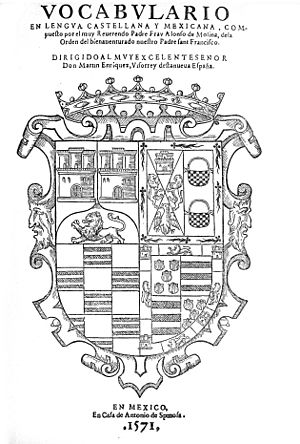Alonso de Molina facts for kids
Alonso de Molina (born around 1513 or 1514 – died around 1579 or 1585) was a Franciscan priest and a language expert. He wrote a very famous dictionary of the Nahuatl language in 1571. This dictionary is still used today by people who study Nahuatl texts. He also created a special guide for priests who worked with communities that spoke Nahuatl.
Contents
Biography
Alonso de Molina was born in Extremadura, Spain, in the Province of Cáceres. He came to Mexico as a child in 1522, during the Spanish conquest of Mexico. He grew up playing with children who spoke only Nahuatl in the streets. At that time, the Aztec capital, Tenochtitlan, was being rebuilt into Mexico City. Because of this, he became very good at speaking Nahuatl.
In 1528, when he was a young man, he joined the Franciscan order in Mexico City and became a friar. He taught at the Colegio de Santa Cruz de Tlatelolco in Tlatelolco. He worked alongside other important scholars like Bernardino de Sahagún and Andrés de Olmos. Students at the school were also very talented. For example, Juan Badiano, a student, translated a Nahuatl book about plants into Latin. Besides his church duties, Molina spent his time studying, understanding, and writing in Nahuatl. He wrote and gave many sermons in the language.
Molina's Dictionary
Alonso de Molina's dictionary, called Vocabulary in Castilian and Mexican language, was created between 1555 and 1571. It was the very first dictionary ever printed in the New World (the Americas)! It was also one of the first organized studies of an Indigenous language. Today, it is still seen as a key tool for anyone studying Classical Nahuatl.
According to historian James Lockhart, Molina's dictionary went far beyond just basic words. It included a huge range of vocabulary and explained many small differences in meaning and grammar.
Molina's work on Nahuatl tools, like his dictionary, was looked at closely by the Inquisition (a religious court). In 1574, he tried to print his dictionary again. It was a very important book for teaching Christianity in Nahuatl. However, the Inquisition made him change parts of his introduction that they thought were incorrect.
James Lockhart used Molina's 1555 dictionary to study how Spanish words became part of the Nahuatl language. Molina's dictionary showed many Spanish nouns that were adopted into Nahuatl. But his dictionary also recorded how Nahuatl speakers described Spanish ideas or objects using their own language. For example, Lockhart listed some of these:
- "bier" (a stand for a coffin) was described as miccatlapechtli, which means "dead-person platform."
- "plow" was described as quaquauhe ielimiquia, meaning "means by which an ox cultivates."
- "justice, the law" (justicia) was described as tlamelahuacahihualiztli, meaning "doing things straight."
- "pirate" was described as acalco tenamoyani, meaning "one who robs people on a boat."
Molina's book Confessionario (1569) included an example of a will. This example showed common parts of Nahuatl wills. These included a prayer, the name and home of the person making the will, a statement that they were of sound mind, how their property would be given to heirs or sold for church services, and a final section naming executors (people who carry out the will) and witnesses.
Works
- Doctrina christiana breve traduzida en lengua mexicana (1547)
- Aquí comiença un vocabulario en la lengua castellana y mexicana (1555)
- Confessionario mayor, en lengua mexicana y castellana (1565)
- Arte de la lengua mexicana y castellana (1571)
- Vocabulario en lengua castellana y mexicana (1571)
- Confessionario breve, en lengua mexicana (1577)
See also
 In Spanish: Alonso de Molina para niños
In Spanish: Alonso de Molina para niños


